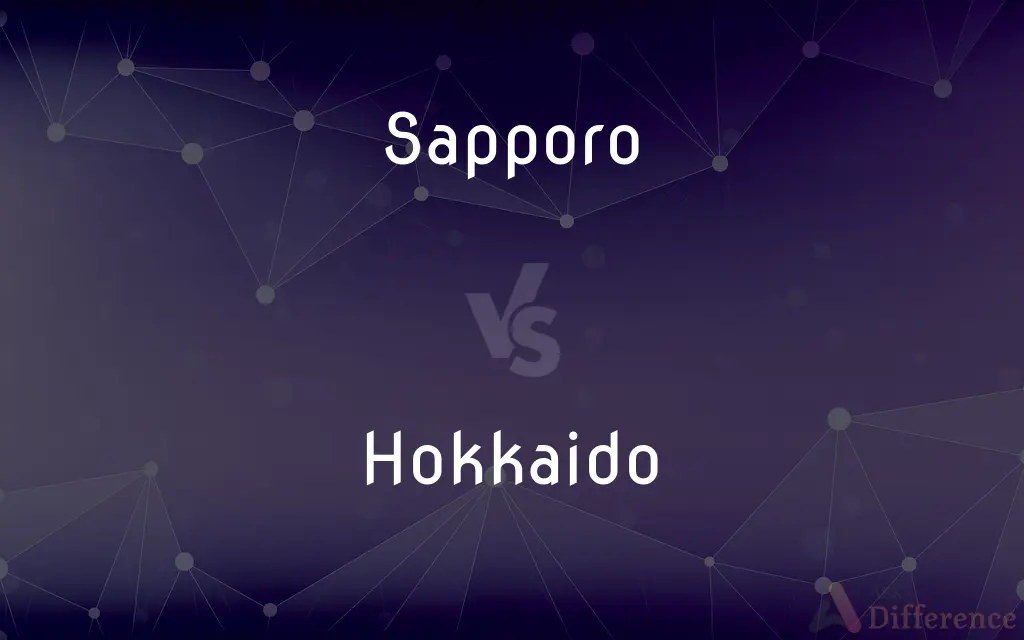Sapporo vs. Hokkaido — What's the Difference?
By Urooj Arif & Fiza Rafique — Updated on April 5, 2024
Sapporo is the capital city of Hokkaido, the northernmost prefecture of Japan, known for its urban attractions, while Hokkaido is celebrated for its vast wilderness and seasonal beauty.

Difference Between Sapporo and Hokkaido
Table of Contents
ADVERTISEMENT
Key Differences
Sapporo, as the capital city of Hokkaido, is a hub of cultural, economic, and educational activities within the prefecture. It's famous for its annual Snow Festival, featuring spectacular ice and snow sculptures, and serves as a gateway for tourists exploring the broader region of Hokkaido. Hokkaido, on the other hand, is known for its breathtaking natural landscapes, including national parks, hot springs, and ski resorts, offering a stark contrast to the urban environment of Sapporo.
While Sapporo offers a vibrant city life with attractions such as the historic Sapporo Beer Museum, the bustling Susukino entertainment district, and Odori Park, Hokkaido appeals to those seeking adventure in the outdoors. The prefecture's vast areas of untouched nature provide opportunities for skiing, hiking, and wildlife observation, especially in areas like Niseko, Furano, and Shiretoko.
The culinary scene in Sapporo is reflective of Hokkaido's rich agricultural and maritime bounty, with fresh seafood, dairy products, and the famous Sapporo ramen. Hokkaido as a whole is renowned for its quality produce, including seafood from the cold waters of the North Pacific, dairy from its vast farms, and fresh vegetables and fruits, such as melons and potatoes.
Sapporo's climate is characterized by cold, snowy winters and mild summers, making it ideal for winter sports. The city hosted the 1972 Winter Olympics, underscoring its reputation as a winter destination. Hokkaido's climate varies more broadly, with its vast size contributing to regional climatic differences, but it generally shares Sapporo's cool summer and snowy winter characteristics, making it a year-round destination for different activities.
Transportation in Sapporo is highly developed, with an extensive subway system, making it easy to navigate the city. Hokkaido's transportation network includes trains, buses, and flights connecting its major cities and towns, but exploring its more remote natural attractions often requires a car, highlighting the contrast in accessibility between urban and rural areas.
ADVERTISEMENT
Comparison Chart
Location
Capital city of Hokkaido
Northernmost prefecture of Japan
Attractions
Snow Festival, Sapporo Beer Museum, Susukino
National parks, hot springs, ski resorts
Cuisine
Famous for Sapporo ramen, fresh seafood
Renowned for seafood, dairy products, melons
Climate
Cold, snowy winters; mild summers
Varied, generally cool summers and snowy winters
Transportation
Extensive subway system, easy city navigation
Broader network; cars often needed for remote areas
Compare with Definitions
Sapporo
Offers a rich culinary scene influenced by Hokkaido's produce.
Visitors to Sapporo enjoy trying different varieties of Sapporo ramen.
Hokkaido
Produces a wide range of high-quality agricultural and seafood products.
Hokkaido's seafood is sought after for its freshness and quality.
Sapporo
A center for cultural and educational activities in Hokkaido.
Many tourists start their Hokkaido journey in Sapporo.
Hokkaido
Requires more extensive travel planning for remote natural attractions.
Exploring Hokkaido's natural beauty often involves road trips.
Sapporo
The capital city of Hokkaido, known for its urban attractions.
Sapporo is famous for its annual Snow Festival.
Hokkaido
The northernmost prefecture of Japan, known for its natural beauty.
Hokkaido is visited for its national parks and outdoor activities.
Sapporo
Has a well-developed public transportation system.
The subway in Sapporo makes it easy to explore the city.
Hokkaido
Offers diverse climates and landscapes across the prefecture.
The climate in Hokkaido varies from coastal areas to its mountainous regions.
Sapporo
Hosted the 1972 Winter Olympics, highlighting its winter sports facilities.
Sapporo's ski resorts are popular destinations in winter.
Hokkaido
Attracts tourists with its outdoor activities year-round.
Hokkaido is popular for skiing in winter and hiking during summer.
Sapporo
Sapporo (札幌市, Sapporo-shi, IPA: [sapːoɾo ɕi]) is the largest city in Japan lying north of Tokyo, and the largest city on Hokkaido, the northernmost main island of the country. It is the capital city of Hokkaido Prefecture and Ishikari Subprefecture.
Hokkaido
Hokkaidō (Japanese: 北海道, Hepburn: Hokkaidō, literally "Northern Sea Circuit" or "Northern Sea Region", pronounced [hokkaidoː]), officially Hokkaidō Circuit Prefecture, is the second largest island of Japan and comprises the largest and northernmost prefecture. The Tsugaru Strait separates Hokkaidō from Honshu; the two islands are connected by the undersea railway Seikan Tunnel.
Sapporo
A commercial city in northern Japan on western Hokkaido
Hokkaido
The northernmost of the main islands of Japan. Together with the islands of Honshu, Kyushu and Shikoku it forms the bulk of the land area of Japan.
Hokkaido
The second largest of the four main islands of Japan; north of Honshu
Common Curiosities
Is Sapporo a good place to experience winter sports?
Yes, Sapporo, with its cold, snowy winters, is ideal for winter sports and even hosted the 1972 Winter Olympics.
Why do people visit Hokkaido?
People visit Hokkaido for its natural landscapes, outdoor activities, and high-quality produce.
Can you easily travel between Sapporo and other parts of Hokkaido?
Yes, Sapporo is well-connected to the rest of Hokkaido by train, bus, and air, though remote areas may require a car.
What makes Hokkaido's cuisine unique?
Hokkaido's cuisine is distinguished by its fresh seafood, dairy, and agricultural products, reflecting the region's rich natural resources.
What is the best time to visit Sapporo?
Winter for the Snow Festival and summer for mild weather and festivals, but Sapporo offers attractions year-round.
What are some popular activities in Hokkaido during summer?
Hiking, flower viewing (like lavender in Furano), and attending local festivals.
How does the climate in Sapporo compare to the rest of Hokkaido?
Sapporo's climate is representative of Hokkaido, with mild summers and snowy winters, but Hokkaido's vast size means climate can vary, especially between coastal and inland areas.
Are there any cultural differences within Hokkaido to be aware of?
Hokkaido is known for its Ainu culture, and there are various places where you can learn about the indigenous people of Japan.
What is Sapporo best known for?
Sapporo is renowned for its Snow Festival, vibrant city life, and rich culinary scene.
Is it easy to find English speakers in Sapporo and Hokkaido?
In Sapporo and major tourist spots, yes, but less so in remote areas.
What are some must-visit natural attractions in Hokkaido?
Must-visit places include Niseko for skiing, Furano for lavender fields, and Shiretoko National Park for wildlife and natural beauty.
Can I see wildlife in Hokkaido?
Yes, Hokkaido is home to diverse wildlife, including brown bears, foxes, and various bird species, especially in national parks.
What is a unique cultural event in Sapporo or Hokkaido?
The Sapporo Snow Festival is unique to Sapporo, drawing visitors from all over the world.
How should I dress for a trip to Sapporo in winter?
Dress in layers with a waterproof outer layer, and don't forget warm accessories like gloves and a hat.
How does Hokkaido's food differ from that of other regions in Japan?
Hokkaido's cuisine is heavily influenced by its agricultural and maritime bounty, making it unique with a focus on freshness and quality.
Share Your Discovery

Previous Comparison
Input vs. Import
Next Comparison
Sandwich vs. SarnieAuthor Spotlight
Written by
Urooj ArifUrooj is a skilled content writer at Ask Difference, known for her exceptional ability to simplify complex topics into engaging and informative content. With a passion for research and a flair for clear, concise writing, she consistently delivers articles that resonate with our diverse audience.
Co-written by
Fiza RafiqueFiza Rafique is a skilled content writer at AskDifference.com, where she meticulously refines and enhances written pieces. Drawing from her vast editorial expertise, Fiza ensures clarity, accuracy, and precision in every article. Passionate about language, she continually seeks to elevate the quality of content for readers worldwide.
















































